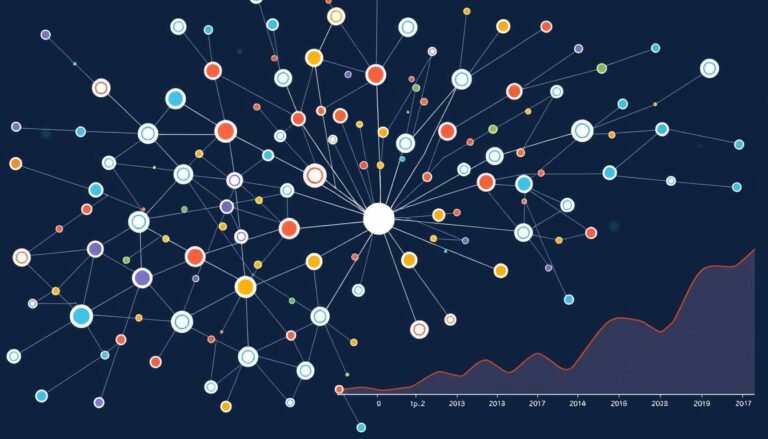How to Leverage Data for Personalization
Did you know that 54% of B2B buyers will switch brands for a personalized experience? In today’s market, making a personalized experience is key. It’s not just an option, it’s a must. In fact, 75% of business leaders see personalization as vital for staying ahead.
With over two and a half quintillion bytes of data collected daily, using this data well is crucial. Yet, many companies find it hard to use data for personalization. Less than half of customer service agents have the info they need to talk to customers well. This shows the need to get better at using data for personalization.
By learning to use data for personalization, businesses can improve customer engagement and increase revenue. This is a big opportunity for growth.
Key Takeaways
- 54% of B2B buyers are willing to switch brands for personalized experiences.
- 75% of business leaders consider personalization a fundamental aspect of competition.
- Leveraging data can boost potential revenue by up to 40%.
- 69% of customers appreciate personalization based on data they’ve shared.
- Companies focusing on customer experience outperform rivals by nearly 80%.
- More than half of businesses have faced trust issues, resulting in substantial revenue loss.
Understanding the Importance of Personalization
The need for a personalized approach in customer interactions is clear. The Zendesk Customer Experience Trends Report 2021 showed that 50% of customers now see customer experience as more important than before. This shift shows how crucial it is for businesses to use data-driven personalization to connect with their audience.
Customers are ready to spend more with companies that offer great experiences. In fact, 75% of consumers say they would pay more for excellent customer service. By using customer data wisely, companies can build stronger bonds and improve how they engage with customers.
Personalization works differently in B2C and B2B sectors. B2C companies use data like age, gender, and income to make interactions personal. B2B firms use firmographic data, including industry details and past relationships, to tailor their approach.
In sectors like SaaS, tools like Snowplow track customer actions. This helps businesses understand what customers do on their websites and after they buy something. By making communication channels more personal, companies can make customers feel valued.
Support teams become more powerful when they have easy access to customer info. This helps them offer services that meet customers’ specific needs. With 72% of companies struggling to personalize CRM, there’s a big chance to get better. Using data well lets companies send messages that really speak to customers. Plus, personalized interactions can lead to more sales, as 42% of targeted calls to action work better than general ones.
Using videos can also make customers happier. Cisco predicts that video will make up 82% of online traffic soon. This shows how important it is to use engaging videos to improve customer connections and grow the business.
Customer Data: A Critical Asset
Customer data is key for companies to improve their products and build stronger relationships with customers. By analyzing customer data, companies can learn what customers like. This helps them make smart choices for personalizing their services.
Gathering Insights on Customer Preferences
To understand what customers want, companies collect different types of data. They use zero-party, first-party, second-party, and third-party data. Surveys give zero-party data, while websites provide first-party info.
This mix of data helps companies make better plans for reaching out to customers.
Monitoring Customer Engagement for Impact
It’s important to see how well marketing works with customers. In B2B, it often takes eight touches to get a meeting. Customer Data Platforms (CDPs) help by analyzing how customers interact in real time.
AI tools suggest the best next steps for reaching out. This way, messages are right on target. By using customer behavior data, companies can spot chances to sell more, meeting customer needs.
| Data Type | Description | Example Sources |
|---|---|---|
| Zero-party data | Voluntarily shared information from customers | Surveys, feedback forms |
| First-party data | Data gathered from owned platforms | Website visits, purchases |
| Second-party data | Shared first-party data from another entity | Partnership data exchanges |
| Third-party data | Data purchased from various sources | Market research firms |
How to Leverage Data for Personalization
Using the right tools is key for great marketing. CRM solutions have changed how businesses handle customer info. Most marketers (87%) see data as their biggest untapped resource.
CRM tools make sure all customer info is up to date. This helps create detailed customer profiles. These profiles let companies send messages that really speak to customers.
Utilizing Customer Relationship Management (CRM) Tools
CRM tools are vital for bringing customer data together from different places. This makes insights clearer for everyone. About 40% of brands are upping their data-driven marketing budgets.
They see the worth in tech that makes the most of customer data. By combining CRM with analytics, teams get insights that lead to action. Using data for targeted marketing makes marketing more personal and keeps customers coming back.
Creating Comprehensive Customer Profiles
Making detailed customer profiles helps brands get what their audience wants and expects. Most consumers (66%) want companies to know their unique likes. Using data smartly brings big wins, with a five to eight times higher ROI.
Real-time data helps create offers that hit the mark. McKinsey says personalization can boost marketing by 10 to 20 percent. This means big revenue growth. With more people wanting personalized experiences, brands need to focus on making their messages more personal.
Key Data-Driven Personalization Strategies
In today’s market, businesses that use smart personalization can really boost customer experiences. They focus on segmenting, analyzing behavior, and micro-personalizing to understand what customers need and like.
Segmentation: The First Step to Effective Personalization
Segmentation is key to good personalization. It groups customers by things like age, buying habits, and behavior. This way, companies can send messages that really speak to each group. Research shows that 91% of people are more likely to interact with brands that offer them things they want.
Segmenting helps send messages that hit the mark, making people more engaged.
Behavioral Analysis: Understanding Customer Journeys
Looking at how customers interact with brands is crucial. By studying these interactions, companies can learn what people like and expect. Using smart algorithms helps predict what customers might do next, making sure messages match what they need right then.
This deep dive into customer behavior helps brands fine-tune their personal touches. It leads to more sales and happier customers.
Micro-Personalization Techniques: Adding a Personal Touch
Micro-personalization takes personalization further by making marketing fit each person’s unique needs. With tools like dynamic content, websites, emails, and pages can change in real-time. This shows a brand cares about what customers want and gets past ad blockers to reach them.
Since 66% of shoppers expect brands to know their special needs, using micro-personalization can make customers stick around longer.
| Technique | Description | Benefits |
|---|---|---|
| Segmentation | Classifying customers based on shared characteristics | Improved targeted messaging and engagement |
| Behavioral Analysis | Examining customer interactions and preferences | Enhanced understanding of customer journeys |
| Micro-Personalization | Customizing interactions at an individual level | Stronger relationships and increased customer loyalty |
Data Optimization Techniques for Enhanced Customer Experience
Using smart data optimization techniques is key to making customer experiences better. By using real-time data, companies can talk to customers at the perfect time. This makes sure that what they say is both timely and relevant.
Knowing when customers are most open lets brands meet their needs right away. This builds stronger bonds with customers.
Real-Time Data Usage for Timely Interaction
Real-time data lets companies quickly react to what customers do. This quick response can make customers happier because they get what they want fast. Having the latest info helps brands make offers that match what customers like.
Studies show that using data well can lead to growth that’s twice as fast. This is compared to not using data at all.
Integrating Multiple Data Sources for Cohesion
Combining data from different places gives a full picture of customers. For example, online stores use past buys and how users act to make shopping better. Car companies use location and weather data for targeted ads.
This full view helps brands keep their messages clear and guess what customers need better. This makes customers more loyal to the brand.
Leveraging Data for Targeted Marketing
In today’s market, using data for targeted marketing is key for businesses. It helps them connect with customers and boost sales. By understanding customer needs and sending out messages that hit the mark, companies can grow.
Identifying Customer Pain Points via Data
Businesses need to use data to see what problems their customers face. Knowing these issues helps them make marketing that really speaks to their audience. This way, brands can make messages that solve customer problems, making customers happier and more loyal.
Crafting Tailored Messages that Resonate
With insights on customer pain points, companies can make messages that really speak to people. Making things personal is important. Data helps shape messages that not only point out problems but also offer solutions that fit what customers need. This makes customers more likely to listen and take action.
Timing Your Outreach for Maximum Impact
Getting the most out of marketing depends a lot on when you reach out. By looking at customer data, companies can figure out the best times to talk to them. Using predictive analytics helps find the perfect moments to engage with customers. This way, messages hit customers when they’re most open to them, turning interest into action.
Enhancing Customer Engagement Through Data
Personalized content is key to boosting customer engagement with data. By using insights from customer interactions, companies can make experiences that fit each person. This makes customers more loyal and happy. When messages match what customers like, it leads to more sales.
Utilizing Personalized Content to Drive Loyalty
Using data to make marketing personal has big benefits. Studies show 80% of people like businesses that know them well. By looking at who customers are, what they like, and how they shop, brands can make better messages. This makes customers feel closer to the brand, which keeps them coming back.
Employing Chatbots with Personalization Capabilities
Adding AI chatbots to customer service makes things even more personal. These chatbots are always there to help, giving answers that matter to each customer. This smart help makes talking to customers smoother, making them feel important. Using data well helps chatbots talk to customers in a way that really connects, making customers happier and more loyal.
| Data Type | Purpose | Example |
|---|---|---|
| First-Party Data | Direct customer insights for personal marketing | Email sign-ups, purchase history |
| Second-Party Data | Shared data to reinforce understanding | Partner collaborations for insights |
| Third-Party Data | Aggregated data to broaden market reach | Industry trends from data vendors |
Using personalized content and smart chatbots changes how customers see a brand. By targeting customers with data-driven strategies, businesses can make a big impact. This approach not only makes customers happier but also boosts the brand’s image in the market.
Conclusion
In the world of online shopping, using data for personalization is key for businesses to do well. Customers now want experiences that are right for them, easy to use, and fit their needs. Brands need to change to meet these high standards.
Personalization helps build loyalty, increases engagement, and makes customers happier. This gives brands a big edge over the competition.
Using smart personalization methods helps companies get to know what customers like. This means offering products that match what people want and sending messages that hit the mark. This approach boosts sales and helps build strong customer bonds.
Since many shoppers leave websites if they don’t have a good experience, it’s clear why personalization matters. By using data wisely, brands can keep up with what customers want. This leads to stronger connections and success in a busy market. Focusing on personal touches helps businesses grow and keep customers happy over time.
Source Links
- 5 Ways to Leverage Personalization in Your B2B Marketing Strategy | elevationb2b.com
- Data-Driven Personalization | How to Leverage & Build Trust | Blog
- How to leverage data and personalization for better customer service
- CRM Personalization: 4 Strategies & Benefits to Leverage Data
- How to Leverage Customer Data for Hyper-Personalized Sales Outreach – CDP.com – Leading CDP Industry Resource for Marketing & Sales
- How to Leverage Customer Data for Small Business Growth – Deep Sync
- Data-Driven Personalization: The Key to Success in Today’s Digital Marketing Landscape
- How to use data to deliver a personalized customer experience
- Personalization Power: Leveraging Data to Deliver Targeted Marketing Experiences
- Data-Driven Personalization: The Key To Success In Today’s Digital Marketing Landscape
- Data-driven Personalization with Customer Data Platform (CDP)
- Here’s How to Optimize Customer Experience with User Data | Kameleoon
- How to Leverage Data and Analytics to Connect With Customers | Entrepreneur
- Leveraging Data Analytics for Hyper-Personalized Marketing Strategies
- Leveraging Data & Personalization In B2B Marketing: Driving Success With ABM – Demand Gen Report
- Contents
- Why Personalization Matters in CX & How to Utilize Data to Improve Customer Experience
- Leveraging Data for Personalization
- What is Personalization?
- What is personalization in customer experience








